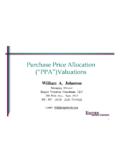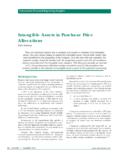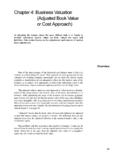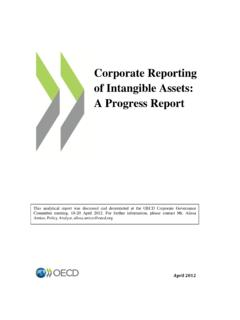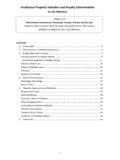Transcription of VALUING PATENTS AND INTANGIBLE ASSETS IN …
1 VALUING PATENTS AND INTANGIBLE ASSETS IN THE SEMICONDUCTOR INDUSTRY by Roy Weinstein and Shane Huang I. Introduction A. INTANGIBLE ASSETS INTANGIBLE ASSETS include PATENTS and other forms of intellectual property that are legally identifiable but of undefined value. Increasingly, they have become the most valuable of corporate ASSETS . How else can one explain the fact that Microsoft, with few major physical ASSETS , is worth far more than GM, with its myriad plants, millions of vehicles and thousands of acres of land? How else can Yahoo be worth more than the New York Times Co.
2 , or be worth more than Barnes & Noble and Borders combined? We set forth below a discussion of issues associated with the valuation of INTANGIBLE ASSETS . We begin by identifying possible approaches to the valuation of semiconductor PATENTS , and then expand the analysis to include a generalized approach to the valuation of all INTANGIBLE ASSETS . B. Semiconductor PATENTS In the past 25 years, the patent and Trademark Office has issued more than 80,000 semiconductor PATENTS . Since many of the manufacturers obtaining those PATENTS use both their own patented technology as well as patented technology developed by other semiconductor manufacturers, industry practice is to enter into cross-license agreements. Typically, parties to such agreements grant each other unlimited access to their patented technology for the duration of the agreement if not longer.
3 The need for access to technology developed by others has increased the importance of correctly VALUING semiconductor PATENTS . This valuation can prove to be a daunting task. II. The Practice of Cross-Licensing Typical market transactions are straightforward: people pay for products or services at prices set by market conditions: $ for a loaf of bread; $ for a movie; $ for an oil change. Even more complex transactions, such as the purchase of an automobile or house, embody prices determined by overall market conditions. Cross-licensing arrangements in the semiconductor industry are far more complex. Such transactions typically involve rights to use entire patent portfolios--strong PATENTS as well as weak ones, old PATENTS as well as new ones--rather than a single product or service.
4 Sometimes money changes hands; other times it is simply a balanced exchange with each company obtaining rights to the other's technology. When payments are involved, they usually take the form of predetermined lump-sum amounts paid over time rather than a running percentage of sales. Whatever the form of transaction, cross-licensing can be attributed to a desire to simplify license negotiations by eliminating the need to reach agreement on a patent -by- patent basis. In the language of economists, the practice of cross-licensing constitutes recognition that PATENTS in the semiconductor industry tend to be complementary products, , the freedom to use another company's patented technology enhances the value of one's own patent portfolio.
5 It suggests that companies benefit from and are willing to pay for " patent peace," , the right to use another's technology without fear of infringement. The practice also derives from the extraordinarily rapid pace of innovation and technological change that characterizes the industry: since it can be difficult, if not impossible, to predict which innovations will prove to be valuable five or ten years in the future, and what, if any, that value will be, the safest, easiest and usually most cost-effective approach taken is to license entire patent portfolios. The licenses exchanged in these agreements generally include all PATENTS that will be applied for during the term of the agreement in addition to any PATENTS owned or controlled by the parties at the onset of the contract term.
6 This means that licensees pay for technology that they may already be using, technology that they might want to use in the future, and technology in which they do not and will never have any interest. They do so because the benefits associated with access to technology that enhances the value of their own intellectual property outweigh the costs of paying for technology that to them is useless. As mentioned above, license agreements may provide rights to technology that is not yet protected or that does not even exist at the time the contract was entered into, but which may be afforded patent protection or come into being and be filed for patent protection before the agreement expires. Such agreements make use of a "capture period" during which all PATENTS issued to or applied for by each party are automatically licensed to the other.
7 An important and sometimes neglected duty in license negotiations is determining the value of these rights, , rights to non-existent technology. A semiconductor manufacturer contemplating a cross-license agreement with a competitor must consider a number of factors before the transaction price can be determined. This is true because the industry is characterized by companies with uneven sales volumes that have developed and/or acquired patent portfolios of non-uniform size and quality. Indeed, within each company's portfolio, some PATENTS may be critical to the manufacture and sale of certain current products; others may be obsolete, may no longer be used, or may not have been incorporated into products to date.
8 Each company may have developed products that rely not only on its own technology, but also on the patented technology of its competitors. As a result, cross-license agreements are fairly common between semiconductor manufacturers. Because sales that rely on licensed technology vary across companies, because that reliance may be of varying degree across a broad range of products, and because companies have patent portfolios of differing size and quality, monies may be exchanged to "balance" the transaction. Texas Instruments, the owner of one of the largest semiconductor patent portfolios, is estimated to earn in excess of $500 million annually in royalty payments from cross-license agreements with many of its lower-sales-volumed competitors, suggesting that, on average, Texas Instruments has possessed a more valuable patent portfolio than the portfolios of companies with whom it has licensed.
9 Several issues are of concern when assessing potential cross-licensing arrangements: A. The relative size of each company's patent portfolio. B. The speed with which each company's patent portfolio is growing, given that a cross-licensing arrangement may be in place for five years or more. Note that since growth in patent portfolios depends upon research and development, value attributed to access to the cross-licensed company's future PATENTS presumes that the company will continue to invest in R&D. One can imagine a situation in which one company reaps the benefits of the other company's research and development but does not maintain its own effort. C. The quality of each portfolio. Two concerns are of particular interest: One company may believe that the other firm cannot produce without using one or more of its PATENTS and therefore expects considerably higher compensation for permission to use those PATENTS .
10 The other company may have different ideas about which, if any, PATENTS it is using and how reliant it is on them. The proportion of useful PATENTS in the portfolio; each company has its own assessment of which of its PATENTS are active and used by the company. D. Contribution of other ASSETS . Exploitation of a patent requires certain physical and INTANGIBLE ASSETS to create the final product. In addition to a return on its patented intellectual property, each company must ensure an adequate return on its physical property and other contributing INTANGIBLE ASSETS . E. Rate of sales growth. As a royalty is applied to sales, each company must anticipate its own sales growth as well as the sales growth of the other company to determine the total compensation it is likely to receive or pay in royalties.



